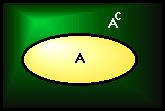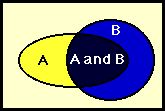
|

|
| The Person who Tossed the Coin | Number of Tosses | Number of Heads | Relative Frequency |
| Buffon (naturalist) Coin | 4040 | 2048 | 2048/4040=0.5069 |
| Pearson (statistician) | 24000 | 12012 | 12012/24000=0.5005 |
| Kerrich (mathematician, in prison) | 10000 | 5067 | 5067/10000=0.5067 |

|
| OUTCOME | A | B | C | D | F | I | W |
| PROBABILITY | 0.2 | 0.3 | 0.2 | 0.1 | 0.1 | 0.05 | ? |
|
Operation |
Explanation |
Notation |
Venn Diagram |
|
Complement of an event A |
The event that A does not occur |
Ac |

|
|
Intersection of A and B |
Both A and B occur at the same time |
A or B |

|
|
Union of A, B |
Either A or B or both occurs At least one of the events A, B occurs |
A and B |

|
Note that being disjoint is a property of events itself, but being independent is a property of the probability of events.
Here is the summary of all the rules
|
GENERAL CASE |
DISJOINT EVENTS |
INDEPENDENT EVENTS |
|
|
Rule 3. Complement Rule |
P(AC)=1-P(A) |
P(AC)=1-P(A) |
P(AC)=1-P(A) |
|
Rule 4. Addition Rule |
P(A or B)= P(A)+P(B)-P(A and B) |
P(A or B)= P(A)+P(B) |
P(A or B)= P(A)+P(B)-P(A)P(B) |
|
Rule 5. Multiplication Rule |
P(A and B)= P(A|B)P(B) |
P(A and B)= 0 |
P(A and B)= P(A)P(B) |
Note that general multiplication rule uses conditional probability. To understand this concept better please work on the activity LET US ROLL A DIE. Here is the formal definition of the conditional probability.
Definition The conditional probability of B given A is:
P(B|A)=P(A and B)/P(A)
Note that for independent events
P(B|A)=P(B)
P(A|B)=P(A)
There are two types of questions that one might face related with the
independence
If you would like to have more information on
"How to Solve Problems
Related with Probability?" and "Use of Probability Trees and Bayes's
Rule", please click on anywhere on this sentence.
Most of the time Bayes's rule is applied to "testing" problem. Here is an
example:
In one of Marilyn Savant's columns in parade Magazine the following
question was asked.
Suppose we assume that 5% of the people are drug-users. The test
is 95% accurate, which we'll say means that if a person is a user, the
result is positive 95% of the time; and if s/he isn't, it's negative 95%
of the time. A randomly chosen person tests positive. Is the individual
highly likely to be a drug-user?
Marilyn's answer was:
Given your condition, once the person has tested positive, you
may as well flip a coin to determine whether she of he is a drug-user.
The chances are only 50-50.
If you are having a hard time understanding why,
please click on any where on this sentence.
If you would like to see another case where Marilyn was right again,
please try the activity
TO SWITCH OR NOT TO SWITCH.
There are two types of random variables
Here are some examples:
Probability Distribution of a Discrete Random Variable lists
all possible values and their probabilities.
Here are some important things that you should be able to do:
When finding mean, variance, and standard deviation of a discrete random
variable, constructing a table like the one below may help.
|
Possible values, xi |
Probability, pi |
xi pi |
(xi-mX) |
(xi-mX)2 |
(xi-mX)2 pi |
|
… |
… |
… |
… |
… |
… |
|
… |
… |
… |
… |
… |
… |
|
… |
… |
… |
… |
… |
… |
|
… |
… |
… |
… |
… |
… |
|
… |
… |
… |
… |
… |
… |
|
… |
… |
… |
… |
… |
… |
|
Sum of this column=m= mean |
Sum of this column=s2 variance |
| SECTION 4.1.Exercise 4.3 (page 293) |
| SECTION 4.2.Exercises 4.11, 4.15, 4.21, 4.25, 4.31, 4.33 (pages 306-312) |
| SECTION 4.3.Exercises 4.41, 4.45 (pages 323, 324) |
| SECTION 4.4.Exercise 4.63 (page 343) |
| SECTION 4.5.Exercises 4.79, 4.87, 4.89, (page 360-363) |